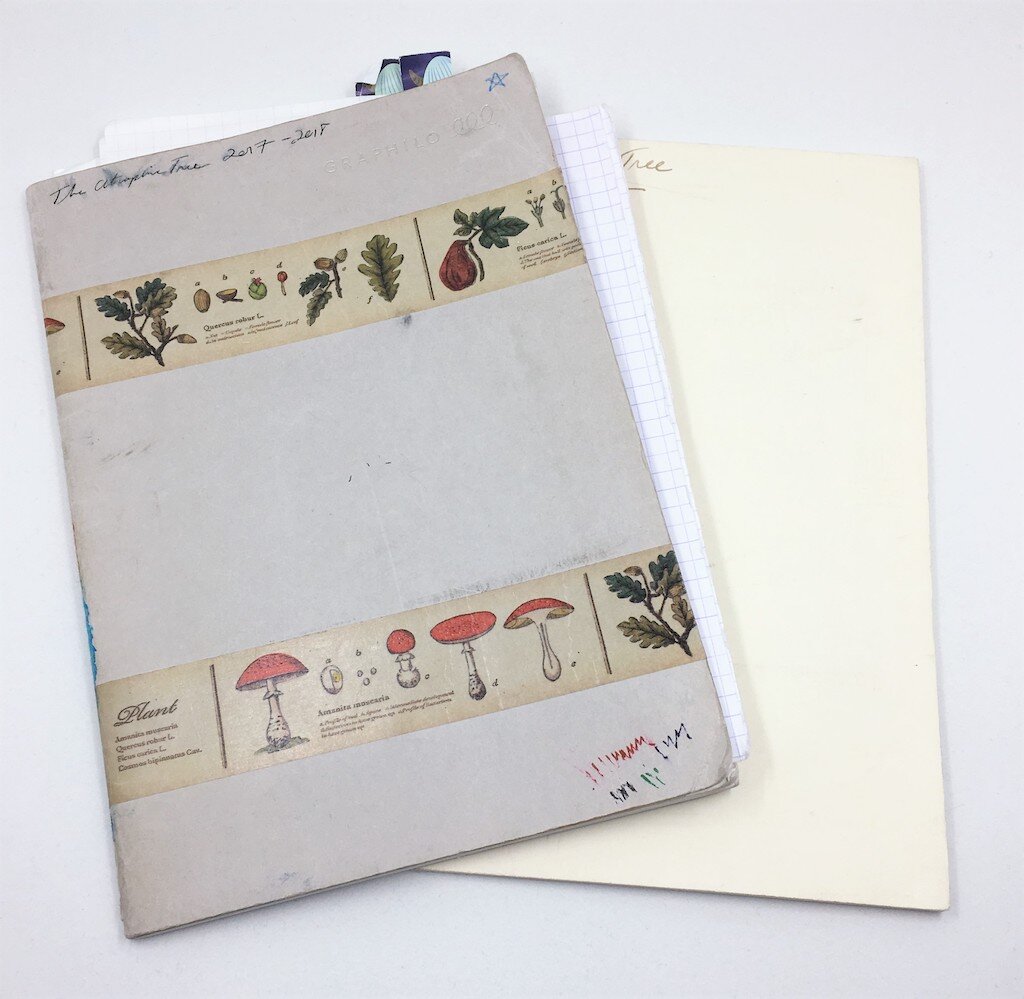(Sarah Read is an author, editor, yarn artist, and pen/paper/ink addict. You can find more about her at her website and on Twitter. And check out her latest book, Out of Water, now available where books are sold!)
Not every writer outlines, but many do--especially if there's a deadline involved. Outlining is very much a discovery process and employs just as much creativity as the writing itself. Sometimes the brainstorms involved can be messy. So what's the best way to keep those ideas roped into a useable order? Some proper stationery tools can help. Everyone's process is a bit different, so ymmv.
A good notebook. For my outlining, I usually use a slim book that becomes my planning, research, outlining, and editing guide for the whole project. That's a tall order, so it must be durable. It needs to last for years! My current one has been in use for two years and five months. Grid rule is ideal, if not essential. It allows you to easily level your indents for different sub headers. I prefer fountain pen friendly books, even though not every page will have fountain pen ink. My favorites so far have been the Graphilo and the Midori MD. Both have just enough pages for their purpose, while still being easily portable. I can slip the notebook in behind the back cover of the journal I'm writing the book in and carry them as a set.
A set of color-coding pens. It's very handy, when outlining, to be able to color code your notes. Whether it's by setting, character, timeline--all of these in conjunction... You may need only a few colors or a LOT of them, depending on the scope of your project. I would suggest a basic set of black, blue, red, and green at the very minimum. You can find those colors within many brands. But if you're penning an epic legend that spans generations of warring houses, you're probably going to need a set with more variety. I prefer gel pens, as it's easier to find large and varied sets with that ink type. My favorite ones to use are the Pilot Maica because of their bright colors, excellent flow, and fine tips that allow me to add notes to margins easily without cluttering the pages too much. Pilot Juice, Uni-Ball Signo, and Zebra Sarasa Clip are also excellent choices. You could use an array of fountain pens all inked with different colors of ink, also, but I found that the difference in line width between pens added some confusion to my notes. For example, pens that wrote more boldly seemed to be emphasized in the text when that information didn't necessarily need to be emphasized. Consistency of line width can be an important factor in keeping outlines tidy. Which brings me to my next point.
A bold pen for headers. When you're scanning your outline for important information, it can be very handy to have important key words and headers written boldly, so they're easy to find at a glance. Character names, places, themes, or scene headers might be good candidates for this. I use either a thick-tipped fineliner in black, like the Sakura Pigma Micron, or a fountain pen with a stub nib to add a bold emphasis to those notes. Either works, but try to stick to the same tool and color throughout, for ease of scanning.
Notecards. Writers love to follow outlines, but characters rarely do. Sometimes seeing the structure of your book on paper isn't enough. Sometimes whole scenes need to move or the plot structure needs to be adjusted. To do that, I recommend making a brief additional outline on notecards (sticky notes work, too) and spreading them out where you can rearrange and shuffle them as needed. Any scrap of paper will work, but my favorite tool for the job are the Nock DotDash note cards. They're fountain pen friendly and have a grid pattern on them, so they work great for mini scene outlines.
Highlighters. Even with color coding and bolding, you're likely going to need another level of emphasis. Maybe to highlight (literally) plot twists or foreshadowing, themes or critical character development. Highlighters are the classic best tool for the job. I don't care much for the typical marker-style chisel-tip highlighters. They do work, but too often I dislike the way they bleed through paper or smear ink. Neon colored pencils are good, but aren't as quick, since it takes some scribbling to cover an area, instead of one swoop. My favorite tool for the job are the Staedtler Textsurfer Gel highlighters, which are basically super-soft gel crayons. You can highlight in a smooth swoop, and the soft wax doesn't bleed through paper or smear ink. One downside, though, as the wax makes it impossible to write over that area again at all.
And of course, the non-stationery ingredient to this list is flexibility. Outlines are the best example of the "guidelines not rules" adage. You're in charge of your story and you can change your mind anytime. Make your story work for you. And if your outline isn't fitting, change the outline! I have three outlines for my current novel, where the story trajectory changed and I needed to re-route things. Maybe add some scissors and scotch tape to this list, too. And a glass of wine.
Tell me your favorite tools for planning your writing projects! Everyone's method is a little different, and I find them all fascinating.
(JetPens provided these products at no charge to The Pen Addict for review purposes.)









